Rodriguez Family Flood Crisis: A Case Study in Crisis Intervention
VerifiedAdded on 2023/06/10
|9
|2060
|418
Case Study
AI Summary
This case study examines the Rodriguez family's experience with a flooding disaster and explores appropriate crisis intervention strategies. The family faces significant challenges, including loss of home and employment, health crises, and emotional distress. The study proposes using the SMART (Strength-centered and Meaning inclined Approach to Resilience and Transformation) model to address their immediate and long-term needs. Various debriefing models and strategies for implementing the SMART model, such as mind-body-spirit affiliation teaching and abandoning pain development elevation, are discussed. The Six Stage Model of Crisis Intervention is also considered, emphasizing problem definition, client safety, support provision, option examination, planning, and commitment. Active listening and facilitative conditions like acceptance, validity, and empathy are highlighted as crucial competencies for humanitarian aid staff in helping victims overcome trauma and rebuild their lives.

Running head: INTRODUCTION TO CRISIS
Introduction to Crisis: Floods Case Study
Student Name
University Affiliation
Introduction to Crisis: Floods Case Study
Student Name
University Affiliation
Paraphrase This Document
Need a fresh take? Get an instant paraphrase of this document with our AI Paraphraser
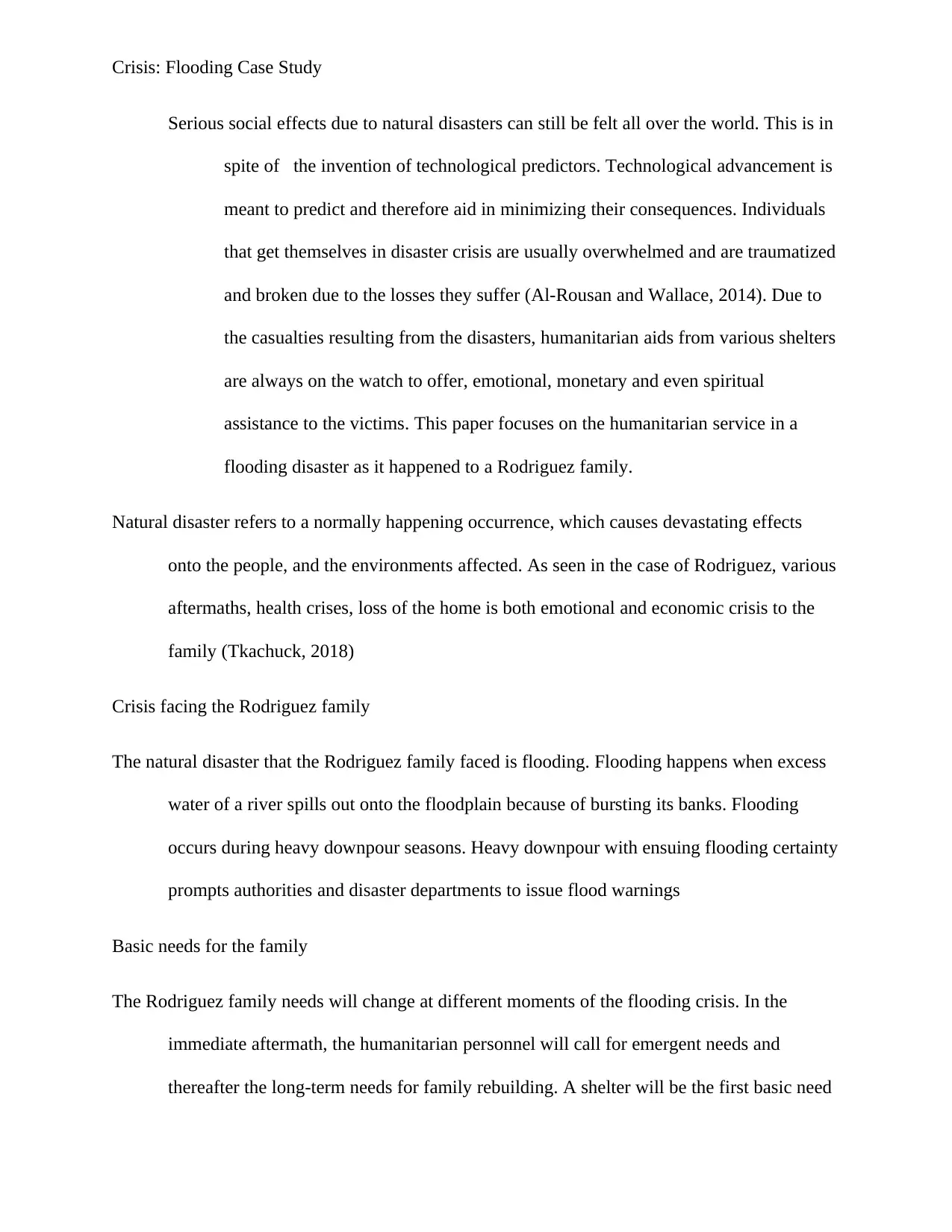
Crisis: Flooding Case Study
Serious social effects due to natural disasters can still be felt all over the world. This is in
spite of the invention of technological predictors. Technological advancement is
meant to predict and therefore aid in minimizing their consequences. Individuals
that get themselves in disaster crisis are usually overwhelmed and are traumatized
and broken due to the losses they suffer (Al-Rousan and Wallace, 2014). Due to
the casualties resulting from the disasters, humanitarian aids from various shelters
are always on the watch to offer, emotional, monetary and even spiritual
assistance to the victims. This paper focuses on the humanitarian service in a
flooding disaster as it happened to a Rodriguez family.
Natural disaster refers to a normally happening occurrence, which causes devastating effects
onto the people, and the environments affected. As seen in the case of Rodriguez, various
aftermaths, health crises, loss of the home is both emotional and economic crisis to the
family (Tkachuck, 2018)
Crisis facing the Rodriguez family
The natural disaster that the Rodriguez family faced is flooding. Flooding happens when excess
water of a river spills out onto the floodplain because of bursting its banks. Flooding
occurs during heavy downpour seasons. Heavy downpour with ensuing flooding certainty
prompts authorities and disaster departments to issue flood warnings
Basic needs for the family
The Rodriguez family needs will change at different moments of the flooding crisis. In the
immediate aftermath, the humanitarian personnel will call for emergent needs and
thereafter the long-term needs for family rebuilding. A shelter will be the first basic need
Serious social effects due to natural disasters can still be felt all over the world. This is in
spite of the invention of technological predictors. Technological advancement is
meant to predict and therefore aid in minimizing their consequences. Individuals
that get themselves in disaster crisis are usually overwhelmed and are traumatized
and broken due to the losses they suffer (Al-Rousan and Wallace, 2014). Due to
the casualties resulting from the disasters, humanitarian aids from various shelters
are always on the watch to offer, emotional, monetary and even spiritual
assistance to the victims. This paper focuses on the humanitarian service in a
flooding disaster as it happened to a Rodriguez family.
Natural disaster refers to a normally happening occurrence, which causes devastating effects
onto the people, and the environments affected. As seen in the case of Rodriguez, various
aftermaths, health crises, loss of the home is both emotional and economic crisis to the
family (Tkachuck, 2018)
Crisis facing the Rodriguez family
The natural disaster that the Rodriguez family faced is flooding. Flooding happens when excess
water of a river spills out onto the floodplain because of bursting its banks. Flooding
occurs during heavy downpour seasons. Heavy downpour with ensuing flooding certainty
prompts authorities and disaster departments to issue flood warnings
Basic needs for the family
The Rodriguez family needs will change at different moments of the flooding crisis. In the
immediate aftermath, the humanitarian personnel will call for emergent needs and
thereafter the long-term needs for family rebuilding. A shelter will be the first basic need
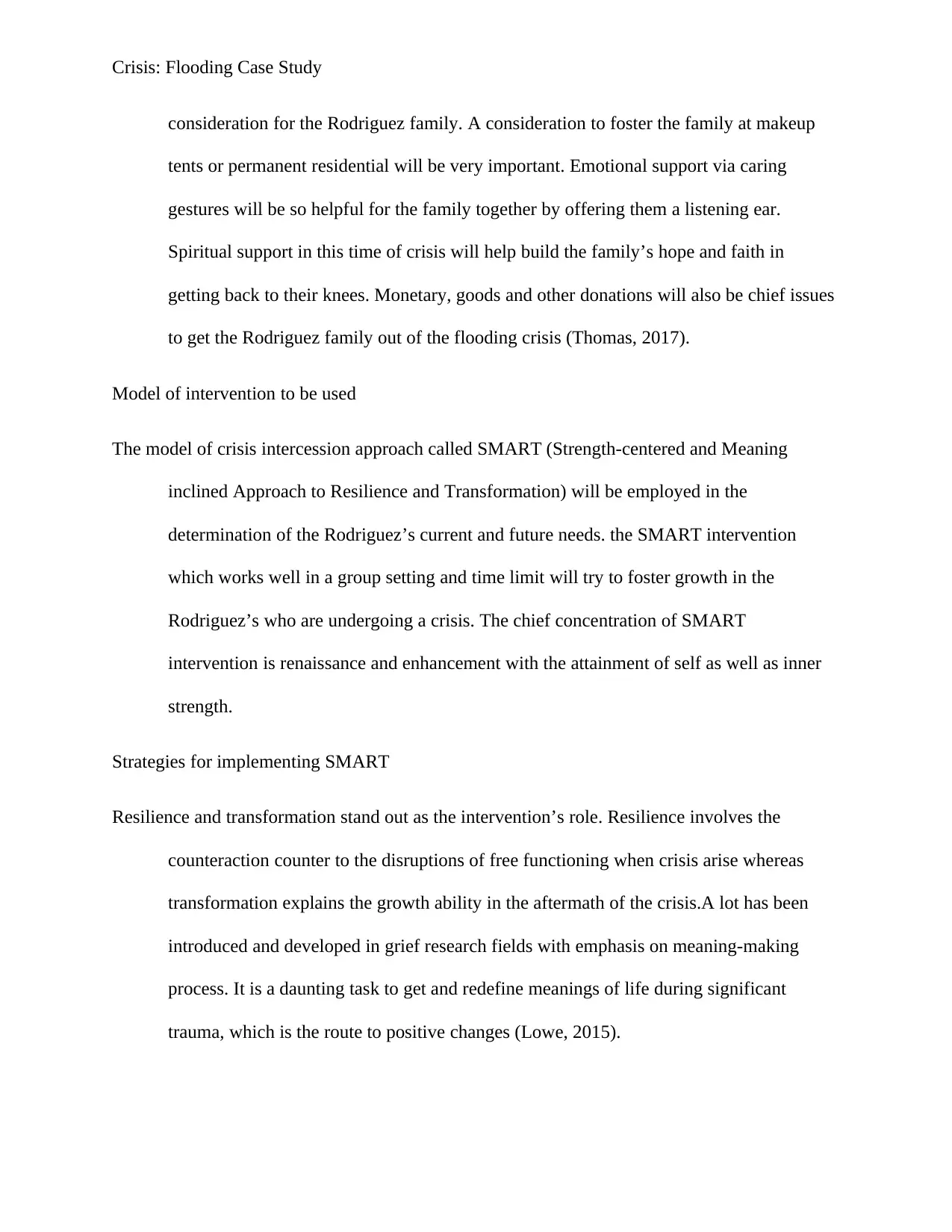
Crisis: Flooding Case Study
consideration for the Rodriguez family. A consideration to foster the family at makeup
tents or permanent residential will be very important. Emotional support via caring
gestures will be so helpful for the family together by offering them a listening ear.
Spiritual support in this time of crisis will help build the family’s hope and faith in
getting back to their knees. Monetary, goods and other donations will also be chief issues
to get the Rodriguez family out of the flooding crisis (Thomas, 2017).
Model of intervention to be used
The model of crisis intercession approach called SMART (Strength-centered and Meaning
inclined Approach to Resilience and Transformation) will be employed in the
determination of the Rodriguez’s current and future needs. the SMART intervention
which works well in a group setting and time limit will try to foster growth in the
Rodriguez’s who are undergoing a crisis. The chief concentration of SMART
intervention is renaissance and enhancement with the attainment of self as well as inner
strength.
Strategies for implementing SMART
Resilience and transformation stand out as the intervention’s role. Resilience involves the
counteraction counter to the disruptions of free functioning when crisis arise whereas
transformation explains the growth ability in the aftermath of the crisis.A lot has been
introduced and developed in grief research fields with emphasis on meaning-making
process. It is a daunting task to get and redefine meanings of life during significant
trauma, which is the route to positive changes (Lowe, 2015).
consideration for the Rodriguez family. A consideration to foster the family at makeup
tents or permanent residential will be very important. Emotional support via caring
gestures will be so helpful for the family together by offering them a listening ear.
Spiritual support in this time of crisis will help build the family’s hope and faith in
getting back to their knees. Monetary, goods and other donations will also be chief issues
to get the Rodriguez family out of the flooding crisis (Thomas, 2017).
Model of intervention to be used
The model of crisis intercession approach called SMART (Strength-centered and Meaning
inclined Approach to Resilience and Transformation) will be employed in the
determination of the Rodriguez’s current and future needs. the SMART intervention
which works well in a group setting and time limit will try to foster growth in the
Rodriguez’s who are undergoing a crisis. The chief concentration of SMART
intervention is renaissance and enhancement with the attainment of self as well as inner
strength.
Strategies for implementing SMART
Resilience and transformation stand out as the intervention’s role. Resilience involves the
counteraction counter to the disruptions of free functioning when crisis arise whereas
transformation explains the growth ability in the aftermath of the crisis.A lot has been
introduced and developed in grief research fields with emphasis on meaning-making
process. It is a daunting task to get and redefine meanings of life during significant
trauma, which is the route to positive changes (Lowe, 2015).
⊘ This is a preview!⊘
Do you want full access?
Subscribe today to unlock all pages.

Trusted by 1+ million students worldwide
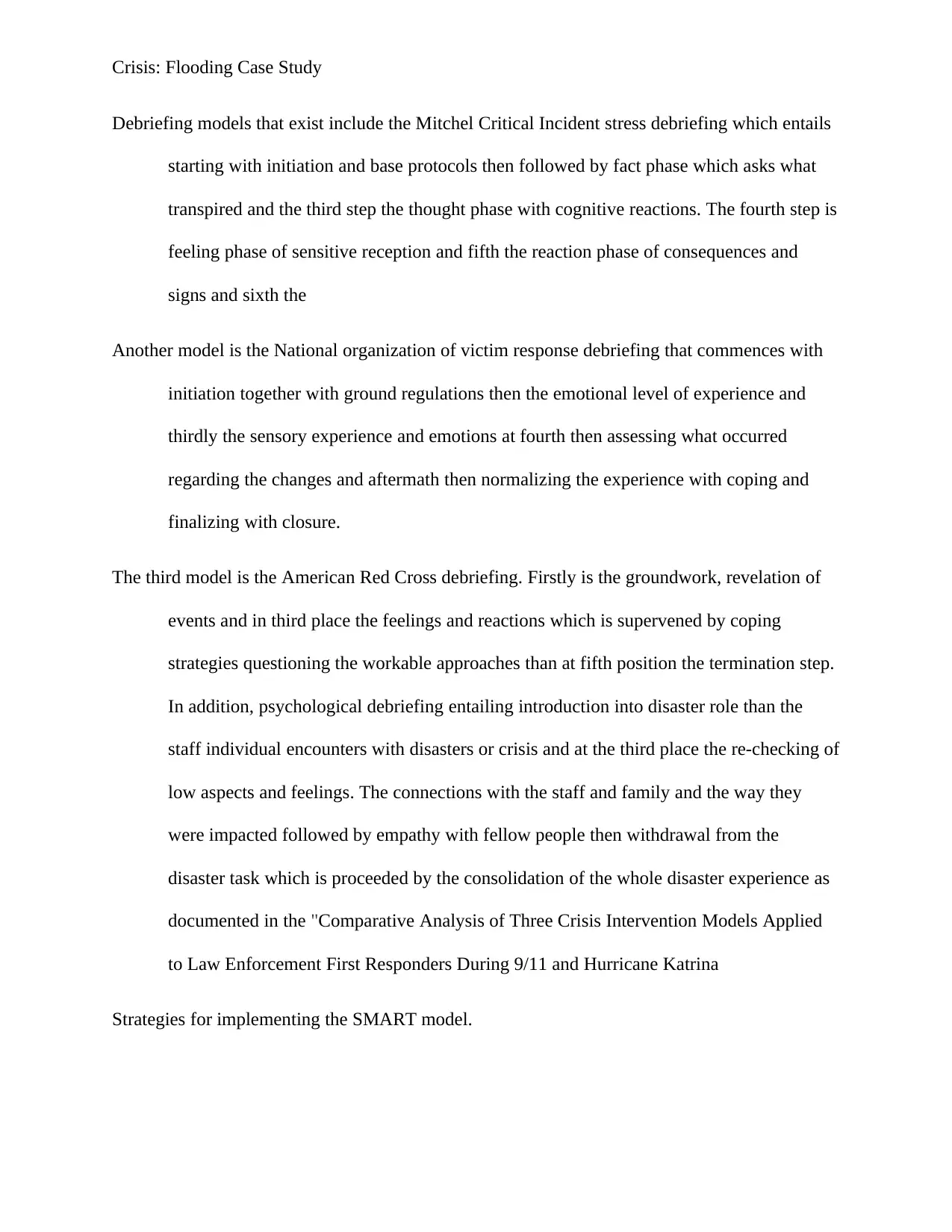
Crisis: Flooding Case Study
Debriefing models that exist include the Mitchel Critical Incident stress debriefing which entails
starting with initiation and base protocols then followed by fact phase which asks what
transpired and the third step the thought phase with cognitive reactions. The fourth step is
feeling phase of sensitive reception and fifth the reaction phase of consequences and
signs and sixth the
Another model is the National organization of victim response debriefing that commences with
initiation together with ground regulations then the emotional level of experience and
thirdly the sensory experience and emotions at fourth then assessing what occurred
regarding the changes and aftermath then normalizing the experience with coping and
finalizing with closure.
The third model is the American Red Cross debriefing. Firstly is the groundwork, revelation of
events and in third place the feelings and reactions which is supervened by coping
strategies questioning the workable approaches than at fifth position the termination step.
In addition, psychological debriefing entailing introduction into disaster role than the
staff individual encounters with disasters or crisis and at the third place the re-checking of
low aspects and feelings. The connections with the staff and family and the way they
were impacted followed by empathy with fellow people then withdrawal from the
disaster task which is proceeded by the consolidation of the whole disaster experience as
documented in the "Comparative Analysis of Three Crisis Intervention Models Applied
to Law Enforcement First Responders During 9/11 and Hurricane Katrina
Strategies for implementing the SMART model.
Debriefing models that exist include the Mitchel Critical Incident stress debriefing which entails
starting with initiation and base protocols then followed by fact phase which asks what
transpired and the third step the thought phase with cognitive reactions. The fourth step is
feeling phase of sensitive reception and fifth the reaction phase of consequences and
signs and sixth the
Another model is the National organization of victim response debriefing that commences with
initiation together with ground regulations then the emotional level of experience and
thirdly the sensory experience and emotions at fourth then assessing what occurred
regarding the changes and aftermath then normalizing the experience with coping and
finalizing with closure.
The third model is the American Red Cross debriefing. Firstly is the groundwork, revelation of
events and in third place the feelings and reactions which is supervened by coping
strategies questioning the workable approaches than at fifth position the termination step.
In addition, psychological debriefing entailing introduction into disaster role than the
staff individual encounters with disasters or crisis and at the third place the re-checking of
low aspects and feelings. The connections with the staff and family and the way they
were impacted followed by empathy with fellow people then withdrawal from the
disaster task which is proceeded by the consolidation of the whole disaster experience as
documented in the "Comparative Analysis of Three Crisis Intervention Models Applied
to Law Enforcement First Responders During 9/11 and Hurricane Katrina
Strategies for implementing the SMART model.
Paraphrase This Document
Need a fresh take? Get an instant paraphrase of this document with our AI Paraphraser
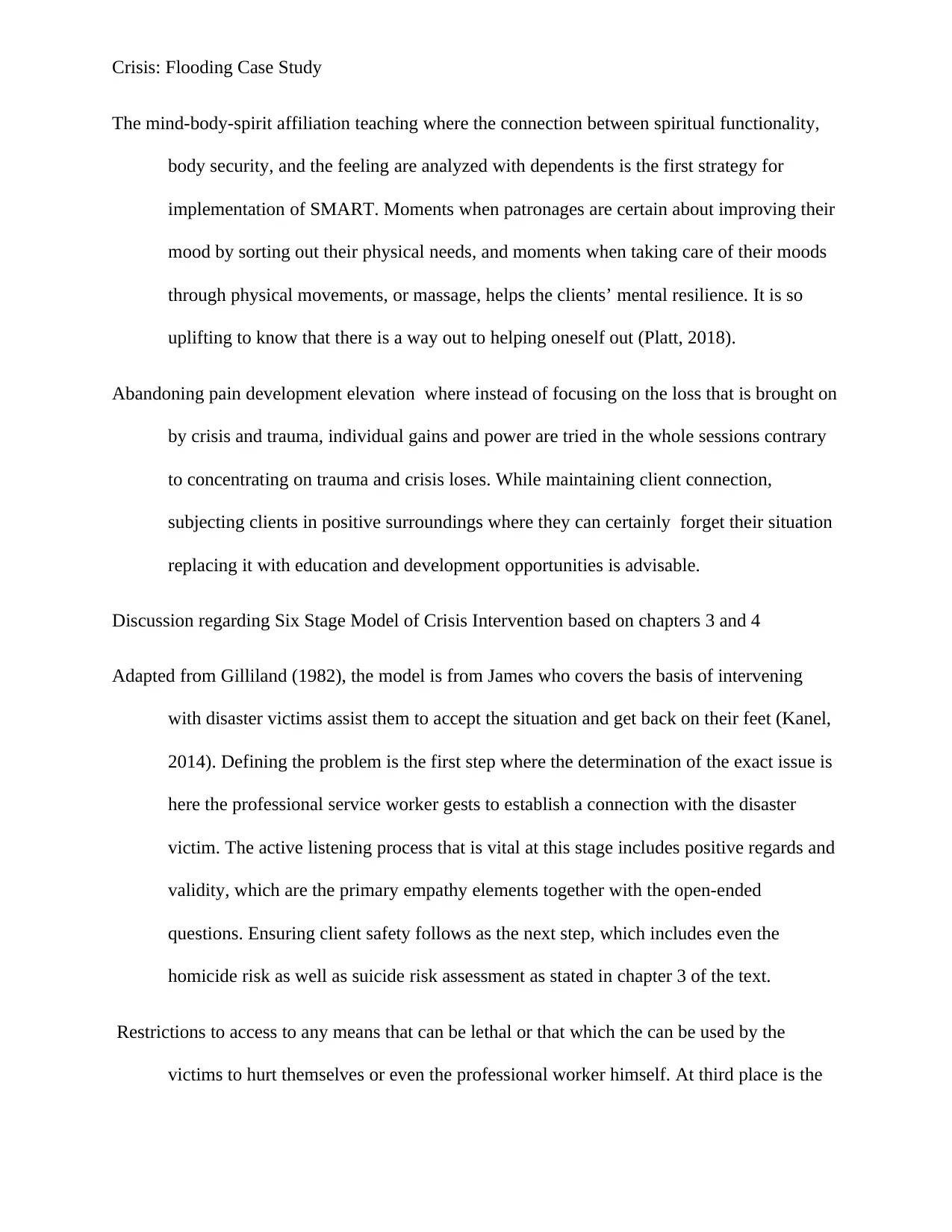
Crisis: Flooding Case Study
The mind-body-spirit affiliation teaching where the connection between spiritual functionality,
body security, and the feeling are analyzed with dependents is the first strategy for
implementation of SMART. Moments when patronages are certain about improving their
mood by sorting out their physical needs, and moments when taking care of their moods
through physical movements, or massage, helps the clients’ mental resilience. It is so
uplifting to know that there is a way out to helping oneself out (Platt, 2018).
Abandoning pain development elevation where instead of focusing on the loss that is brought on
by crisis and trauma, individual gains and power are tried in the whole sessions contrary
to concentrating on trauma and crisis loses. While maintaining client connection,
subjecting clients in positive surroundings where they can certainly forget their situation
replacing it with education and development opportunities is advisable.
Discussion regarding Six Stage Model of Crisis Intervention based on chapters 3 and 4
Adapted from Gilliland (1982), the model is from James who covers the basis of intervening
with disaster victims assist them to accept the situation and get back on their feet (Kanel,
2014). Defining the problem is the first step where the determination of the exact issue is
here the professional service worker gests to establish a connection with the disaster
victim. The active listening process that is vital at this stage includes positive regards and
validity, which are the primary empathy elements together with the open-ended
questions. Ensuring client safety follows as the next step, which includes even the
homicide risk as well as suicide risk assessment as stated in chapter 3 of the text.
Restrictions to access to any means that can be lethal or that which the can be used by the
victims to hurt themselves or even the professional worker himself. At third place is the
The mind-body-spirit affiliation teaching where the connection between spiritual functionality,
body security, and the feeling are analyzed with dependents is the first strategy for
implementation of SMART. Moments when patronages are certain about improving their
mood by sorting out their physical needs, and moments when taking care of their moods
through physical movements, or massage, helps the clients’ mental resilience. It is so
uplifting to know that there is a way out to helping oneself out (Platt, 2018).
Abandoning pain development elevation where instead of focusing on the loss that is brought on
by crisis and trauma, individual gains and power are tried in the whole sessions contrary
to concentrating on trauma and crisis loses. While maintaining client connection,
subjecting clients in positive surroundings where they can certainly forget their situation
replacing it with education and development opportunities is advisable.
Discussion regarding Six Stage Model of Crisis Intervention based on chapters 3 and 4
Adapted from Gilliland (1982), the model is from James who covers the basis of intervening
with disaster victims assist them to accept the situation and get back on their feet (Kanel,
2014). Defining the problem is the first step where the determination of the exact issue is
here the professional service worker gests to establish a connection with the disaster
victim. The active listening process that is vital at this stage includes positive regards and
validity, which are the primary empathy elements together with the open-ended
questions. Ensuring client safety follows as the next step, which includes even the
homicide risk as well as suicide risk assessment as stated in chapter 3 of the text.
Restrictions to access to any means that can be lethal or that which the can be used by the
victims to hurt themselves or even the professional worker himself. At third place is the
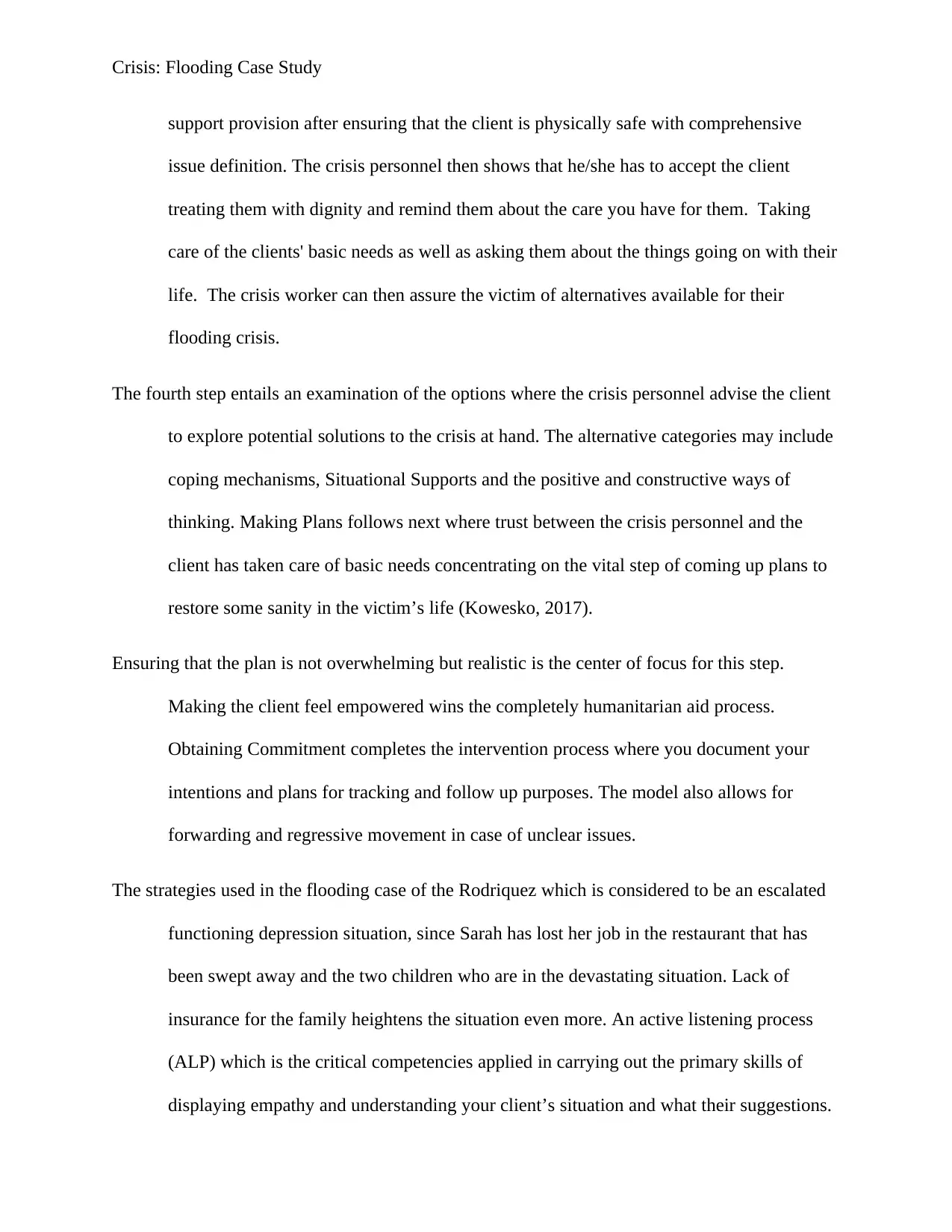
Crisis: Flooding Case Study
support provision after ensuring that the client is physically safe with comprehensive
issue definition. The crisis personnel then shows that he/she has to accept the client
treating them with dignity and remind them about the care you have for them. Taking
care of the clients' basic needs as well as asking them about the things going on with their
life. The crisis worker can then assure the victim of alternatives available for their
flooding crisis.
The fourth step entails an examination of the options where the crisis personnel advise the client
to explore potential solutions to the crisis at hand. The alternative categories may include
coping mechanisms, Situational Supports and the positive and constructive ways of
thinking. Making Plans follows next where trust between the crisis personnel and the
client has taken care of basic needs concentrating on the vital step of coming up plans to
restore some sanity in the victim’s life (Kowesko, 2017).
Ensuring that the plan is not overwhelming but realistic is the center of focus for this step.
Making the client feel empowered wins the completely humanitarian aid process.
Obtaining Commitment completes the intervention process where you document your
intentions and plans for tracking and follow up purposes. The model also allows for
forwarding and regressive movement in case of unclear issues.
The strategies used in the flooding case of the Rodriquez which is considered to be an escalated
functioning depression situation, since Sarah has lost her job in the restaurant that has
been swept away and the two children who are in the devastating situation. Lack of
insurance for the family heightens the situation even more. An active listening process
(ALP) which is the critical competencies applied in carrying out the primary skills of
displaying empathy and understanding your client’s situation and what their suggestions.
support provision after ensuring that the client is physically safe with comprehensive
issue definition. The crisis personnel then shows that he/she has to accept the client
treating them with dignity and remind them about the care you have for them. Taking
care of the clients' basic needs as well as asking them about the things going on with their
life. The crisis worker can then assure the victim of alternatives available for their
flooding crisis.
The fourth step entails an examination of the options where the crisis personnel advise the client
to explore potential solutions to the crisis at hand. The alternative categories may include
coping mechanisms, Situational Supports and the positive and constructive ways of
thinking. Making Plans follows next where trust between the crisis personnel and the
client has taken care of basic needs concentrating on the vital step of coming up plans to
restore some sanity in the victim’s life (Kowesko, 2017).
Ensuring that the plan is not overwhelming but realistic is the center of focus for this step.
Making the client feel empowered wins the completely humanitarian aid process.
Obtaining Commitment completes the intervention process where you document your
intentions and plans for tracking and follow up purposes. The model also allows for
forwarding and regressive movement in case of unclear issues.
The strategies used in the flooding case of the Rodriquez which is considered to be an escalated
functioning depression situation, since Sarah has lost her job in the restaurant that has
been swept away and the two children who are in the devastating situation. Lack of
insurance for the family heightens the situation even more. An active listening process
(ALP) which is the critical competencies applied in carrying out the primary skills of
displaying empathy and understanding your client’s situation and what their suggestions.
⊘ This is a preview!⊘
Do you want full access?
Subscribe today to unlock all pages.

Trusted by 1+ million students worldwide
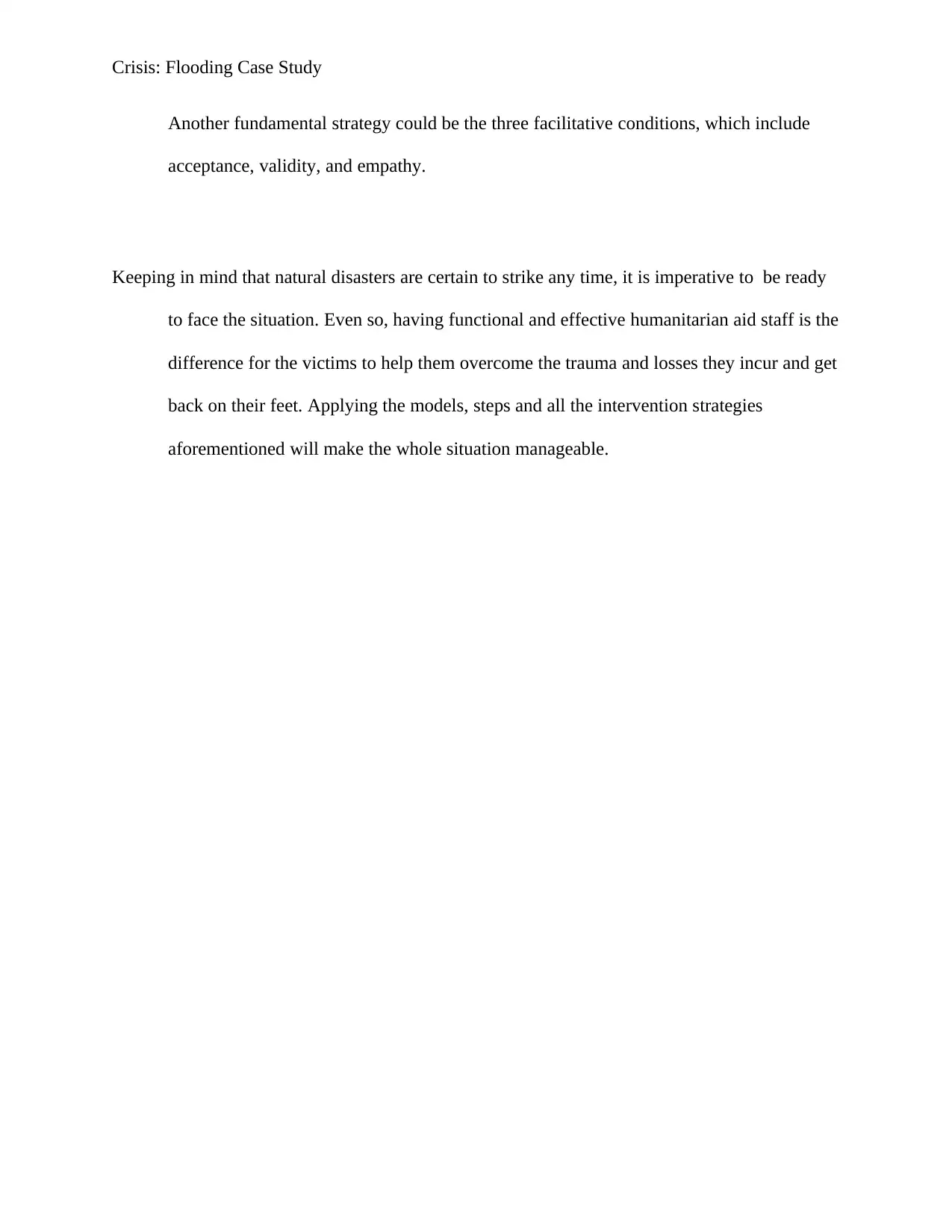
Crisis: Flooding Case Study
Another fundamental strategy could be the three facilitative conditions, which include
acceptance, validity, and empathy.
Keeping in mind that natural disasters are certain to strike any time, it is imperative to be ready
to face the situation. Even so, having functional and effective humanitarian aid staff is the
difference for the victims to help them overcome the trauma and losses they incur and get
back on their feet. Applying the models, steps and all the intervention strategies
aforementioned will make the whole situation manageable.
Another fundamental strategy could be the three facilitative conditions, which include
acceptance, validity, and empathy.
Keeping in mind that natural disasters are certain to strike any time, it is imperative to be ready
to face the situation. Even so, having functional and effective humanitarian aid staff is the
difference for the victims to help them overcome the trauma and losses they incur and get
back on their feet. Applying the models, steps and all the intervention strategies
aforementioned will make the whole situation manageable.
Paraphrase This Document
Need a fresh take? Get an instant paraphrase of this document with our AI Paraphraser
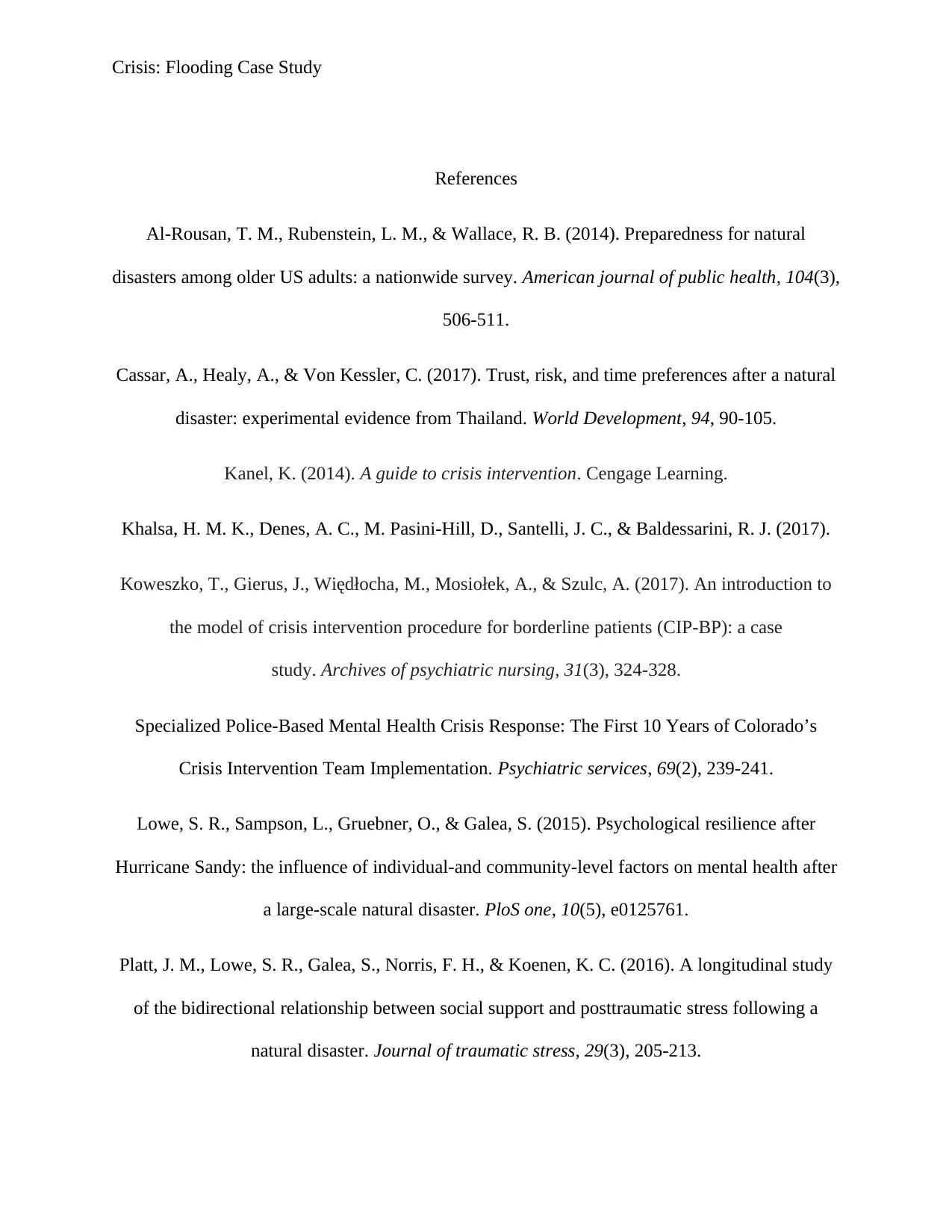
Crisis: Flooding Case Study
References
Al-Rousan, T. M., Rubenstein, L. M., & Wallace, R. B. (2014). Preparedness for natural
disasters among older US adults: a nationwide survey. American journal of public health, 104(3),
506-511.
Cassar, A., Healy, A., & Von Kessler, C. (2017). Trust, risk, and time preferences after a natural
disaster: experimental evidence from Thailand. World Development, 94, 90-105.
Kanel, K. (2014). A guide to crisis intervention. Cengage Learning.
Khalsa, H. M. K., Denes, A. C., M. Pasini-Hill, D., Santelli, J. C., & Baldessarini, R. J. (2017).
Koweszko, T., Gierus, J., Więdłocha, M., Mosiołek, A., & Szulc, A. (2017). An introduction to
the model of crisis intervention procedure for borderline patients (CIP-BP): a case
study. Archives of psychiatric nursing, 31(3), 324-328.
Specialized Police-Based Mental Health Crisis Response: The First 10 Years of Colorado’s
Crisis Intervention Team Implementation. Psychiatric services, 69(2), 239-241.
Lowe, S. R., Sampson, L., Gruebner, O., & Galea, S. (2015). Psychological resilience after
Hurricane Sandy: the influence of individual-and community-level factors on mental health after
a large-scale natural disaster. PloS one, 10(5), e0125761.
Platt, J. M., Lowe, S. R., Galea, S., Norris, F. H., & Koenen, K. C. (2016). A longitudinal study
of the bidirectional relationship between social support and posttraumatic stress following a
natural disaster. Journal of traumatic stress, 29(3), 205-213.
References
Al-Rousan, T. M., Rubenstein, L. M., & Wallace, R. B. (2014). Preparedness for natural
disasters among older US adults: a nationwide survey. American journal of public health, 104(3),
506-511.
Cassar, A., Healy, A., & Von Kessler, C. (2017). Trust, risk, and time preferences after a natural
disaster: experimental evidence from Thailand. World Development, 94, 90-105.
Kanel, K. (2014). A guide to crisis intervention. Cengage Learning.
Khalsa, H. M. K., Denes, A. C., M. Pasini-Hill, D., Santelli, J. C., & Baldessarini, R. J. (2017).
Koweszko, T., Gierus, J., Więdłocha, M., Mosiołek, A., & Szulc, A. (2017). An introduction to
the model of crisis intervention procedure for borderline patients (CIP-BP): a case
study. Archives of psychiatric nursing, 31(3), 324-328.
Specialized Police-Based Mental Health Crisis Response: The First 10 Years of Colorado’s
Crisis Intervention Team Implementation. Psychiatric services, 69(2), 239-241.
Lowe, S. R., Sampson, L., Gruebner, O., & Galea, S. (2015). Psychological resilience after
Hurricane Sandy: the influence of individual-and community-level factors on mental health after
a large-scale natural disaster. PloS one, 10(5), e0125761.
Platt, J. M., Lowe, S. R., Galea, S., Norris, F. H., & Koenen, K. C. (2016). A longitudinal study
of the bidirectional relationship between social support and posttraumatic stress following a
natural disaster. Journal of traumatic stress, 29(3), 205-213.
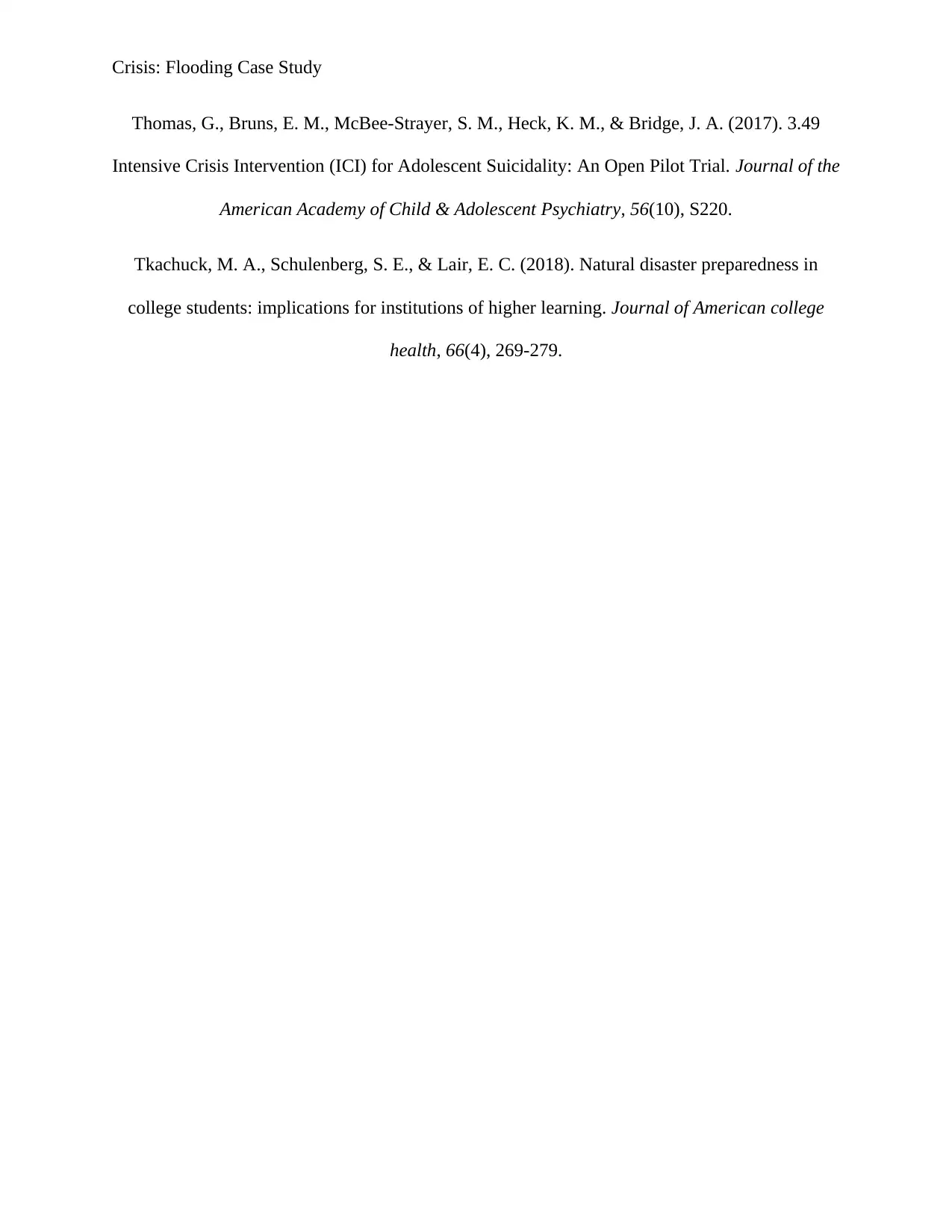
Crisis: Flooding Case Study
Thomas, G., Bruns, E. M., McBee-Strayer, S. M., Heck, K. M., & Bridge, J. A. (2017). 3.49
Intensive Crisis Intervention (ICI) for Adolescent Suicidality: An Open Pilot Trial. Journal of the
American Academy of Child & Adolescent Psychiatry, 56(10), S220.
Tkachuck, M. A., Schulenberg, S. E., & Lair, E. C. (2018). Natural disaster preparedness in
college students: implications for institutions of higher learning. Journal of American college
health, 66(4), 269-279.
Thomas, G., Bruns, E. M., McBee-Strayer, S. M., Heck, K. M., & Bridge, J. A. (2017). 3.49
Intensive Crisis Intervention (ICI) for Adolescent Suicidality: An Open Pilot Trial. Journal of the
American Academy of Child & Adolescent Psychiatry, 56(10), S220.
Tkachuck, M. A., Schulenberg, S. E., & Lair, E. C. (2018). Natural disaster preparedness in
college students: implications for institutions of higher learning. Journal of American college
health, 66(4), 269-279.
⊘ This is a preview!⊘
Do you want full access?
Subscribe today to unlock all pages.

Trusted by 1+ million students worldwide
1 out of 9
Your All-in-One AI-Powered Toolkit for Academic Success.
+13062052269
info@desklib.com
Available 24*7 on WhatsApp / Email
![[object Object]](/_next/static/media/star-bottom.7253800d.svg)
Unlock your academic potential
Copyright © 2020–2025 A2Z Services. All Rights Reserved. Developed and managed by ZUCOL.